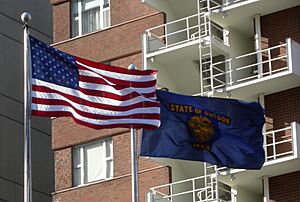Flag of Oregon facts for kids
The flag of Oregon is special because it has a different design on each side! It is mostly navy blue and gold. On the front, you'll see a shield from the state seal. On the back, there's a gold picture of a beaver, which is Oregon's state animal.
Oregon is the only U.S. state with a flag that has different pictures on its front and back. This makes it very unique!
Contents
History of the Oregon Flag
The current flag of Oregon officially started being used on February 26, 1925. The very first Oregon flag was made that same year. It was sewn by two employees of a department store, Marjorie Kennedy and Blanche Cox.
This first flag was later given to Eastern Oregon University in 1954. It was donated by the grandson of a former governor, Walter M. Pierce. In 2010, this important historical flag was carefully fixed up and restored.
Trying to Change the Flag
The current Oregon flag was once ranked in a survey by the North American Vexillological Association. This group studies flags. Out of 72 flags from U.S. states, U.S. territories, and Canadian provinces, Oregon's flag was ranked 62nd.
For Oregon's 150th birthday in 2013, a newspaper called The Oregonian held a contest. They asked people to design a new state flag. Many people sent in their ideas, and the public voted on them.
The winning design was made by Randall Gray, a map maker. His design focused on the beaver, which is already on the back of the current flag. A star in his design showed Oregon's place in the United States. The color green stood for Oregon's beautiful forests and nature.
However, during the voting, many people asked for an option to keep the old flag. This option was added as "NONE OF THE ABOVE." In the end, "NONE" received the most votes, meaning people wanted to keep the current flag.
In 2013, a bill was suggested in the Oregon Senate to change the flag. But this bill never became a law. It was supported by State Senator Laurie Monnes Anderson and a resident named Matt Norquist.
The proposed new flag would have had two vertical parts: navy blue on the left and gold on the right. A gold beaver would be on the blue part. The gold part would have a vertical navy blue stripe with a white star in the middle. Both sides of this new flag would have looked the same.
What the Oregon Flag Looks Like
The flag is mostly navy blue, and all the words and symbols are in gold. These are Oregon's official state colors.
On the front side of the flag, you can read STATE OF OREGON. This is written above a shield. This shield is also part of the Oregon state seal. Around the shield, there are 33 stars. These stars show that Oregon was the 33rd state to join the United States. Below the shield, you'll see the year 1859. This is the year Oregon became a state.
Oregon's flag is the only state flag in the U.S. that has different pictures on its front and back. The country of Paraguay is the only country that still has a two-sided flag. Flags with different designs on each side used to be more common. But they are now rare because it costs more to make them.
On the back side of the Oregon flag, there is a gold picture of a beaver. The beaver is the official state animal of Oregon.
For special events or parades, the flag might have a gold fringe around its edges. But for everyday use, this fringe is not needed. The flag's width is 3 units for every 5 units of its length.
See also
 In Spanish: Bandera de Oregón para niños
In Spanish: Bandera de Oregón para niños




